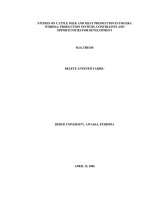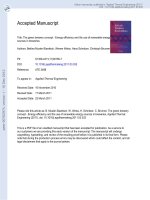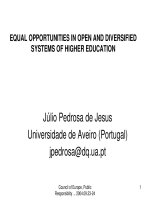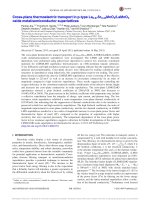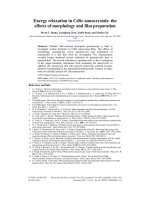Nonequilibrium energy transport in time dependent driven systems
Bạn đang xem bản rút gọn của tài liệu. Xem và tải ngay bản đầy đủ của tài liệu tại đây (1.54 MB, 110 trang )
NONEQUILIBRIUM ENERGY
TRANSPORT IN TIME-DEPENDENT
DRIVEN SYSTEMS
REN Jie
NATIONAL UNIVERSITY OF SINGAPORE
2012
NONEQUILIBRIUM ENERGY
TRANSPORT IN TIME-DEPENDENT
DRIVEN SYSTEMS
REN Jie
A THESIS SUBMITTED
FOR THE DEGREE OF DOCTOR OF PHILOSOPHY
NUS Graduate School for Integrative Sciences and
Engineering
NATIONAL UNIVERSITY OF SINGAPORE
2012
c
⃝
Copyright by
REN Jie
2012
All Rights Reserved
Acknowledgements
Pursuing PhD in NUS is a very happy and valuable period of time for me. I
thoroughly enjoy being a member in the group full of intellectual atmosphere
furnished by my supervisor, Baowen Li. Without his thoughtful advice, patient
guidance and collaboration, I could not have finished or explored as much as
I have. Especially, I am grateful to Baowen for sharing his high standard
of behaving and his constant generous support for my research, which are
invaluable for my whole research career. Many thanks to all my collaborators,
seniors, colleagues and visiting scholars of our NUS group for making our group
a stimulating and friendly place. Of particular notes are Lifa Zhang and Chen
Wang. It is a pleasure to collaborate with them, a mutual give and take of
idea and knowledge.
There are a number of mentors as well as collaborators who I have been for-
tunate to know and whose guidance is invaluable. I am very appreciative
of Peter H¨anggi for his insightful advice and collaboration. He has taught
me the importance of clear and precise thinking. I would also like to thank
Zhisong Wang for his mentorship on molecular motors. My gratitude extends
to Jian-Xin Zhu, Nikolai Sinitsyn and Xiangdong Ding for their thoughtful
discussion, selfless collab oration and kind hospitality during my visit to Los
Alamos National Lab.
Many thanks to Zhaolei Zhang for inviting me to visit University of Toronto
and I have learnt a lot about Bioinformatics, Computational System Biology
and Evolutionary Genomics. Although, at the last several months, it was a
i
really “severe winter” in my life, I have suffered a lot and have also matured
a lot. Thank you, Jingjing Li, Cherry and Zineng Yuan for being there.
I wish to express my thanks to Ying-Cheng Lai for offering me the opportunity
of visiting and collaborating with his energetic group at Arizona State Univer-
sity. I always benefit a lot from his tremendous knowledge and insights. And
I have learnt a lot from the stimulating discussion and collaboration with his
group members: Wen-Xu Wang, Liang Huang, Riqi Su, Rui Yang, Xuan Ni.
In fact, they are my old friends and I really enjoy the wonderful life I spent
with them all at Arizona.
I am also grateful to Gang Yan and his wife for hosting me to finish this thesis.
It is a pleasure to discuss with Gang Yan the gossips and of course the science.
Finally, I am forever indebted to my family for their love, support, and en-
couragement. Mom, Dad, thank you and I love you!
ii
Abstract
Heat conduction and electric conduction are two fundamental energy trans-
port phenomena in nature. However, they have never been treated equally,
because unlike electrons, the carriers of heat–phonons–are just quantized vi-
bration modes that possess no mass or charge, which makes phonon transport
hard to be controlled. Nevertheless, a new discipline–phononics emerges, which
is the science and technology of phonons, aimed to manipulate heat flow and
render thermal energy to be controlled as flexibly as electronics. To achieve
this ultimate goal, various thermal devices, like thermal diode, thermal tran-
sistor, thermal memory have been proposed theoretically and partially been
realized in experiments.
The control of heat flow in the above mentioned thermal devices is managed
mainly by applying a static thermal bias with heat commonly flowing on av-
erage from “hot” to “cool”. In order to obtain an even more flexible control
of heat energy comparable with the richness available for electronics, one may
design intriguing phononic devices which utilize temporal modulations as well.
More intriguing control of transport emerges when the manipulations are made
explicitly time-dependent.
In this thesis, I will talk about the dynamic control of nonequilibrium thermal
energy transport by various time-dependent driving.
I will first show that an efficient pumping or shuttling of energy across spatially
extended nano-structures can be realized via modulating either one or more
thermal bath temperatures, or applying external time-dependent fields, such as
iii
mechanical/electric/magnetic forces. This gives rise to a plethora of intriguing
phononic phenomena such as a directed shuttling of heat against an external
thermal bias, multiple thermal resonances. Three necessary conditions for the
emergence of heat current without or even against thermal bias are unraveled.
Then I will show if more than a single parameter is modulated in time, the
system response is also affected, apart from its dynamic (phase) response, by
the manner the modulation proceeds in parameter space. This in turn yields
a geometric phase contribution which affects the overall heat transport in a
geometric Berry-phase like manner. I will discuss the geometric-phase effect
on time-dependent driven heat transport in both quantum and classic systems
in details. Finally, the possible experimental setup of electric circuits to verify
the prediction about geometric-phase effects on time-dependent heat transport
is discussed as well.
As a conclusion, the dynamic control scheme allows for a most fine-tuned
control of the energy transport.
iv
List of Publications
[1] Jie Ren, Sha Liu, and B. Li, “Geometric Heat Flux of Classical Thermal
Transport in Interacting Open Systems”, under review in Phys. Rev. Lett.
[2] S. Zhang, Jie Ren, and B. Li, “Multiresonance of energy transport and
absence of heat pump in a force-driven lattice”, Phys. Rev. E 84, 031122
(2011).
[3] L. Zhang, Jie Ren, J S. Wang, and B. Li, “The phonon Hall effect: theory
and application”, J. Phys.: Condens. Matter 23, 305402 (2011).
[4] Jie Ren, V. Y. Chernyak, and N. A. Sinitsyn, “Duality and fluctuation
relations for statistics of currents on cyclic graphs”, J. Stat. Mech. P05011
(2011).
[5] L. Zhang, Jie Ren, J S. Wang, and B. Li, “Topological Nature of Phonon
Hall Effect,”, Phys. Rev. Lett., 105, 225901 (2010).
[6] Jie Ren, P. H¨anggi, and B. Li, “Berry-Phase-Induced Heat Pumping and Its
Impact on the Fluctuation Theorem”, Phys. Rev. Lett. 104, 170601 (2010).
[8] Jie Ren and B. Li, “Emergence and control of heat current from strict zero
thermal bias”, Phys. Rev. E 81, 021111 (2010).
[9] Jie Ren, W X. Wang, B. Li, and Y C. Lai, “Noise Bridges Dynamical
Correlation and Topology in Coupled Oscillator Networks”, Phys. Rev. Lett.
104, 058701 (2010).
[10] Jie Ren and B. Li, “Thermodynamic stability of small-world oscillator
networks: A case study of proteins” Phys. Rev. E 79, 051922 (2009).
v
Contents
Acknowledgements i
Abstract iii
List of Publications v
Contents vi
List of Figures viii
1 Introduction 1
1.1 Phononics . . . . . . . . . . . . . . . . . . . . . . . . . . . . . . 3
1.2 Dynamic Control and Geometric Phases . . . . . . . . . . . . . 5
1.3 Objectives . . . . . . . . . . . . . . . . . . . . . . . . . . . . . . 9
2 Dynamical Control for Time-Dependent Heat Shuttling 12
2.1 Periodic Temperature-Driving . . . . . . . . . . . . . . . . . . . 12
2.1.1 Model and method . . . . . . . . . . . . . . . . . . . . . 14
2.1.2 Parameter dependence of heat shuttling . . . . . . . . . 16
2.1.3 Correlation effect of thermal baths . . . . . . . . . . . . 21
vi
2.1.4 Three conditions for heat shuttling . . . . . . . . . . . . 25
2.2 Periodic Mechanical-Force-Driving . . . . . . . . . . . . . . . . . 26
2.2.1 Model and method . . . . . . . . . . . . . . . . . . . . . 28
2.2.2 Analytic results for harmonic lattice . . . . . . . . . . . 31
2.2.3 Multiple resonances in FK model . . . . . . . . . . . . . 38
2.2.4 Absence of heat pumping . . . . . . . . . . . . . . . . . . 42
2.3 Conclusion and Discussion . . . . . . . . . . . . . . . . . . . . . 49
3 Geometric Phase Effect in Time-Dependent Heat Transport 54
3.1 Quantum Model: Single Molecular Junction . . . . . . . . . . . 54
3.1.1 Model and method . . . . . . . . . . . . . . . . . . . . . 57
3.1.2 Geometric Berry-phase effect . . . . . . . . . . . . . . . 58
3.1.3 Fractional quantized phonon response . . . . . . . . . . . 65
3.1.4 Impact of Berry-phase on Fluctuation Theorem. . . . . . 69
3.2 Classic Model: Coupled Oscillators . . . . . . . . . . . . . . . . 71
3.2.1 Model and method . . . . . . . . . . . . . . . . . . . . . 71
3.2.2 Exact solutions for twisted Fokker-Planck equation . . . 73
3.2.3 Geometric-phase effect in coupled oscillators . . . . . . . 77
3.2.4 Purposed electric circuit experiment . . . . . . . . . . . . 83
3.3 Conclusion and Discussion . . . . . . . . . . . . . . . . . . . . . 85
4 Summary and Future Works 87
Bibliography 91
vii
List of Figures
1.1 Integration of electronics, photonics and phononics . . . . . . . 2
2.1 One-dimensional two segment FK lattice . . . . . . . . . . . . . 14
2.2 Frequency resonance effect . . . . . . . . . . . . . . . . . . . . . 17
2.3 Temperature tuning effect . . . . . . . . . . . . . . . . . . . . . 19
2.4 System size effect . . . . . . . . . . . . . . . . . . . . . . . . . . 20
2.5 Thermal bath correlation effect . . . . . . . . . . . . . . . . . . 22
2.6 Scheme of force-driven FK lattices . . . . . . . . . . . . . . . . . 28
2.7 Crossover from sing- to multi-resonance of energy current . . . . 30
2.8 Multi-resonance of energy current in harmonic lattices . . . . . . 35
2.9 Comparison of resonant behaviors in harmonic and FK lattice . 37
2.10 Energy current vs driving frequency for large force . . . . . . . . 39
2.11 Temperature effect on multiresonance of force-driven lattices . . 41
2.12 Dissection of energy flux into heat flux and work flux . . . . . . 43
2.13 Energy flow diagram in force-driven model and rigorous heat
pump . . . . . . . . . . . . . . . . . . . . . . . . . . . . . . . . . 44
viii
3.1 Scheme of the two-level molecular junction . . . . . . . . . . . . 56
3.2 Geometric-phase-induced heat pump . . . . . . . . . . . . . . . 63
3.3 Temperature modulation cycle and level transitions . . . . . . . 66
3.4 Fractional quantization of phonon response . . . . . . . . . . . . 68
3.5 Coupled oscillators and electric circuits . . . . . . . . . . . . . . 72
3.6 Nonlinear effect on geometric-phase-induced heat pump . . . . . 82
ix
Chapter 1
Introduction
Energy harvesting and waste is a great bottleneck in the supply of energy re-
sources to a sustainable economy. Besides developing carbon-free green energy
sources, the global energy crisis can be alleviated by enhancing the efficiency
of energy utilization. We are now at a new stage of control energy and matter
at nanoscale. Such nanoscale control creates unprecedented opportunities to
directing and conversion of energy in order to achieve the greater energy sus-
tainability. Among various forms of energy, heat, electricity and light are three
conventional ones. For electrons and photons, their theories are well developed
and have wide applications with great impacts on our everyday life. However,
the carriers of heat–phonons are just quantized vibration modes that possess
no mass or charge, which is difficult to be controlled by electromagnetic field.
In view of the “heat” problem everywhere, such as air conditioning, heat dissi-
pating of CPU, quantum cooling, it is desirable to efficiently control phonons
at nanoscale [1–4].
In the last decade, the fast development of both theoretic nanoscale
transport and applied nanotechnology has witnessed the emergence of a new
1
2
Figure 1.1: Scheme of the integration of electronics, photonics and phononics.
discipline—phononics [5]. It is the science and technology of phonons, aimed
to manipulate heat flow and render thermal energy to be controlled as flexibly
as electronics. Phononics also play the role of bridging electronics with the
so-called thermoelectrics [6, 7], bridging photonics with the so-called optome-
chanics [8]. Future generation of multimode energy harvester rests with the
integration and control of electronics, photonics, and phononics (as shown in
Fig. 1.1). Therefore, a fundamental understanding of non-equilibrium trans-
port of vibrational thermal energy carried by phonons becomes critical.
1.1. Phononics 3
1.1 Phononics
Phononics is the science and technology in controlling of thermal energy and
processing information carried by phonons [5]. The task of directing phonons
on the nanoscale requires some necessary counterparts known from electronics,
which mimic the familiar role of electric diodes, electric transistors and alike
for electronic circuitry. A first challenge then is to design blue prints for such
components that function for heat (phonon) control alike those components do
for electron transport. This can be best approached by making use of the non-
linear dynamics present in anharmonic lattice structures in combination with
the implementation of asymmetry. Indeed, various thermal devices have been
successfully proposed, such as thermal rectifiers [9–11], thermal transistor [12],
thermal logical gates [13], thermal memory [14] and other molecular thermal
machines [15–17]. Moreover, the solid-state thermal diode has been even re-
alized in experiments [18–21] as well as heat transistor [22], the solid-state
thermal memory [23].
The research of thermal diode can be traced back to 1930s, when Chauncey
Starr at Rensselaer Polytechnic Institute in New York built an asymmetric
junction composed of a metallic copper part and a cuprous oxide part, which
possesses the asymmetric heat conduction and functions as a thermal rectifi-
er [24]. After that, various macroscopic thermal rectifiers have been studied,
which function via the different material response to the temperature bias
and/or other mechanisms [25].
A new round of the research tide of thermal diode originates from the
merging of research communities from solid-state physics and nonlinear dy-
1.1. Phononics 4
namics. In 2002, Marcello Terraneo and co-workers proposed a thermal diode
based on resonance [9]. The authors used a three-segment structure by sand-
wiching a nonlinear lattice with two harmonic ones. They found that heat can
easily flow in one direction but not the other. Later, Li’s group used a simpler
two-segment nonlinear lattices and demonstrated a thermal diode with much
higher rectification efficiency [10]. These pioneering theoretical works in turn
ignited a flurry of experimental activities. In 2006, Chih-Wei Chang and co-
workers built the first nanoscale solid-state heat diode, where the conductance
of an asymmetric nanotube is 3 ∼ 7% larger in one direction than that in the
other direction [18]. The thermal diodes in a semiconductor quantum dot [19]
and cobalt oxide of asymmetric geometry [20, 21] have b een realized as well,
which forms a major step towards the experimental realization of Phononics.
To achieve a more flexible heat control, or even logic operations and useful
circuitry, however, additional control of phonon is required. Li’s group in
Singapore has moved further towards the Phononics, by theoretically designing
various thermal analogs of electric devices.
In 2006, by utilizing the negative differential thermal resistance, a first
thermal transistor has been theoretically proposed [12]. The negative differen-
tial thermal resistance makes it possible to build thermal logic gates, which has
been realized one year later [13]. Also, the negative differential thermal resis-
tance makes the multi-stable heat conduction possible by delicately designing
the architecture of the nonlinear lattices. Thus, with the help of multi-stable
heat conduction, a first thermal memory has been demonstrated by the same
group, in which thermal information (high/low temperature) can be written
1.2. Dynamic Control and Geometric Phases 5
and read out [14]. In view of those theoretical thermal devices including ther-
mal diode, thermal transistors, thermal logic gates, and thermal memory, a
possible thermal computer is thus believed to be coming to reality in the near
future.
Such rapid progress in phononic devices encourages lots of works on the
thermal conductivity/conductance of different materials, which I will not re-
view here.
1.2 Dynamic Control and Geometric Phases
So far, the function of the various thermal devices has been achieved by use
of a static thermal bias with heat commonly flowing on average from “hot”
to “cold”. In order to obtain an even more flexible control of heat energy
comparable with the richness available for electronics, one may design intrigu-
ing phononic devices which utilize temporal modulation to achieve dynamic
control as well. Such dynamic control makes possible the realization of a
plethora of novel phenomena such as the heat ratchet effect, absolute negative
heat conductance or the machinery of Brownian (heat) motors, to name but a
few [32–34]. Among the necessary ingredients to run such heat machinery of
dynamic control are thermal noise, nonlinearity, unbiased nonequilibrium driv-
ing of deterministic or stochastic nature and some sort of symmetry breaking
mechanism. This dynamic control then carries the setup away from thermal
equilibrium, thereby circumventing the second law of thermodynamics, which
otherwise would impose a vanishing directed transport.
Dynamical engineering of materials offers a fascinating possibility to mod-
1.2. Dynamic Control and Geometric Phases 6
ify transport properties at will. Under the dynamic control, it has been shown
that the electronic band structures of materials can be dramatically modified
as well as the electric transport properties [28–31]. We expect that the similar
behaviors can be triggered by dynamic control of heat transport.
Dwelling of similar ideas used in Brownian motors for directing parti-
cle flow, an efficient pumping or shuttling of energy across spatially extended
nano-structures can be realized via modulating either one or more thermal
bath temperatures, or applying external time-dependent fields, such as me-
chanical/electric/magnetic forces. This gives rise to a plethora of intriguing
phononic phenomena such as a directed shuttling of heat against an external
thermal bias or the pumping of heat induced by a non-vanishing geometric
(Berry)-phase.
In 1984, Michael Berry wrote a seminal paper [36] about adiabatic evolu-
tion of an eigenstate when the Hamiltonian is changed by the external param-
eters extremely slowly. Berry pointed out that in the absence of degeneracy,
when the Hamiltonian finishes an evolution loop in the parameter space, the
eigenstate will go back to itself but with an additional phase different from
original one. This additional phase equals to a dynamical phase factor result-
ing from the time integral of the eigen-energy plus an extra contributed by
the change of the eigen-function, which is later commonly named as the Berry
phase. Berry phase is like the Aharonov-Bohm phase but in a parameter space.
It is an important concept and has generated broad interests throughout the
various fields of physics.
In the following let us briefly introduce the basic concepts of Berry phase
1.2. Dynamic Control and Geometric Phases 7
following the recent review article [35]. Let a Hamiltonian H = H(R(t))
evolves with time through varying a set of parameters, denoted by R =
(R
1
, R
2
, . . . ). For a closed path in the parameter space, denoted as C, R( t)
evolves cyclically such that R(T ) = R(0). Assuming an extremely slow evolu-
tion of the system as R(t) moves along the path C, we have
H(R)|n(R)⟩ = ε
n
(R)|n(R)⟩ . (1.1)
However, the above equation implies the phase factor of the orthonormal eigen-
states |n(R)⟩ is not determinate since the phase factor can be arbitrary. One
can make a gauge choice to remove the arbitrariness, provided that the phase
of the basis function is smooth and single-valued along the path C in the pa-
rameter space. A system prepared in one state |n(R(0))⟩ will evolve with
H(R(t)) and dwell in the state |n(R(t))⟩ in time t according the quantum
adiabatic theorem [26,27], thus one can write the state at time t as
|ψ
n
(t)⟩ = e
iγ
n
(t)
e
−
i
¯h
∫
t
0
dt
′
ε
n
(R(t
′
))
|n(R(t))⟩ , (1.2)
where the second exponential is known as the dynamical phase factor. Then,
what is the first exponential? Inserting Eq. (1.2) into the time-dependent
Schr¨odinger equation
i¯h
∂
∂t
|ψ
n
(t)⟩ = H(R(t))|ψ
n
(t)⟩ (1.3)
and left multiplying ⟨n(R(t))|, one finds that γ
n
can be expressed as a path
integral in the parameter space
γ
n
=
C
dR ·A
n
(R) , (1.4)
1.2. Dynamic Control and Geometric Phases 8
where A
n
(R) is called Berry connection or the Berry vector potential written
as
A
n
(R) = i⟨n(R)|
∂
∂R
|n(R)⟩ . (1.5)
It shows that in addition to the dynamical phase, the quantum state will
acquire an additional phase during the adiabatic evolution. The Berry vec-
tor potential A
n
(R) is gauge-dependent. If we make a gauge transformation
|n(R)⟩ → e
iζ(R)
|n(R)⟩ with ζ(R) being an arbitrary smooth function, A
n
(R)
transforms according to A
n
(R) → A
n
(R) −
∂
∂R
ζ(R) . However because of the
system evolves along a closed path C with R(T ) = R(0), the phase choice we
made earlier on the basis function |n(R)⟩ requires e
iζ(R)
in the gauge transfor-
mation to be single-valued, which implies ζ(R(0)) −ζ(R(T )) = 2π ×integer
This shows that γ
n
can be only changed by an integer multiple of 2π and it
cannot be removed. Therefore the Berry phase γ
n
is a gauge-invariant physical
quantity.
In analogy to electrodynamics, a gauge field tensor can be derived from
the Berry vector potential:
F
n
µν
(R) =
∂
∂R
µ
A
n
ν
(R) −
∂
∂R
ν
A
n
µ
(R)
= i
⟨
∂n(R)
∂R
µ
|
∂n(R)
∂R
ν
⟩ −(ν ↔ µ)
. (1.6)
This field is called the Berry curvature, which can be also written as a sum-
mation over the eigenstates:
F
n
µν
(R) = i
n
′
̸=n
⟨n|
∂H(R)
∂R
µ
|n
′
⟩⟨n
′
|
∂H(R)
∂R
ν
|n⟩ −(ν ↔ µ)
(ε
n
− ε
n
′
)
2
. (1.7)
In fact, the geometric phase effect is not unique in quantum mechanics. It
may be emergent from any system, if the corresponding parameter space has
1.3. Objectives 9
nontrivial geometry. One example is the so-called anholonomy angle in the
elementary geometry, which can appear in the parallel transport of a vector
along a closed loop on a sphere. You can image that you now take a compass
needle traveling on the earth. You start from the north pole and move to
the equator. Meanwhile, the pointer of your compass needle always points to
the south. And then, you move along the equator for a while. After that,
you move back to the north pole from the equator, with the pointer of your
compass needle always pointing to the south. Finally, when you are back to you
original starting point, you will be surprised that the direction of the pointer
is not back to its original direction! There is an additional rotation angle, so-
called anholonomy angle, which actually is connected to the intrinsic curvature
of the sphere. If we do the same parallel transport on a trivial geometry,
say a flat plane, then, this additional rotation angle is absent because of the
zero curvature. Another example is in the full counting statistics of cyclic
driven systems [51], the cumulant generating function (analog of phase) in the
exponent of the characteristic function (analog of wave function) will also gain
an additional term. The extra term shares the similar geometric origin from
the nontrivial curvature in the system’s parameter space. The geometric-phase
effect we are going to study in this thesis refers to the latter.
1.3 Objectives
The mainstream of the research on phononics is on the static steady-state
heat transport. A fundamental understanding of the nonequilibrium energy
transport in time-dependent driven systems is still lacking. Therefore the
1.3. Objectives 10
objectives of this thesis are
1. To explore the rich phenomenon of dynamic control of heat transport
and study the parameter-dependency and the underlying mechanism.
2. To unravel the conditions for directing heat energy without/against ther-
mal bias, which would provide a guideline for optimal design of nanoscale
heat pump.
3. To develop the exact theories of geometric(Berry)-phase-induced heat
flux generating function and examine its impact on the properties of
time-dependent heat transport.
4. To study the geometric-phase-induced heat pump on b oth quantum and
classic systems and discuss the possible experimental verification of the-
oretical predictions.
The results of the present research may have significance on the under-
standing of the nonequilibrium energy transport in time-dependent driven
systems. It provides insights on the understanding of a rich nonequilibrium
transport phenomenon. The conditions uncovered in this research could pro-
vide guidelines for optimal design of time-driven thermal devices for dynamic
control of phonons. The focus of this thesis is then to analytically study the
possible geometric-phase effect on the time-dependent heat transport in both
the quantum and classic systems. It should be noted that the present study are
restricted on the adiabatic limit–extremely slow driving. More general theory,
with the insight from Floquet theory, could be developed in the future.
1.3. Objectives 11
In the following of this thesis, we will first study the periodic temperature
driving in the first part of Chapter 2; and then the periodic mechanic-force
driving in the second part of Chapter 2. In Chapter 3, we will study the
geometric-phase effect on the heat transport in time-dependent driven system,
both quantum and classic. In the end, a summary of this thesis and future
prospects will be given in Chapter 4.
Chapter 2
Dynamical Control for
Time-Dependent Heat Shuttling
2.1 Periodic Temperature-Driving
Understanding heat transfer at the molecular level is of fundamental and prac-
tical importance [1]. Recent years have witnessed a fast development in the
emerging field of phononics [5], wherein phonons, rather than an annoyance,
can be used to carry and process information. To manipulate and control
phonon transport (heat current) on the molecular level, various thermal de-
vices [5] have been proposed, such as the thermal diode [9–11,37–39], thermal
transistor [12], thermal logic gate [13] and thermal memory [14]. On the oth-
er hand, experimental works such as thermal rectifier [18, 20] and nanotube
phonon waveguide [40] have been carried out. These theoretical and experi-
mental works render the heat current to be controlled as flexibly as electric
current in a foreseeable future.
Heat transfers spontaneously from a high temperature to a low one; thus,
the control of heat current has been so far based on the control of the temper-
12
2.1. Periodic Temperature-Driving 13
ature gradient. However, a large temperature gradient is essentially difficult
to maintain over small distance in practice, especially at nanoscale. Conse-
quently, a natural question is raised: can we create and control heat current
in the absence of (or against) thermal bias at nanoscale; if yes, then how do
we do that?
Inspired by ideas from Brownian motors [32–34], originally devised for
particle transport, a few studies have revealed the possibility of pumping heat
against thermal gradients at nanoscale [15, 16, 41–45]. A molecular model
with modulated energy levels has been found to perform the heat pumping
operation [15,43]. However the microscopic oscillator system, though built on
the similar principles, fails to perform the pumping [16]. Thus, it is still not
clear what the requirements are for the system to show such functional effect.
In this section, we attempt to answer this novel and important question: how
do we create and control heat current at strict zero thermal bias?
It is noted that some interesting works reveal that nonzero heat current
survives when one bath temp erature is driven but with equal average (but dif-
ferent at any instant) to the other bath temperature [44,45]. However, this re-
ported behavior can be understood through the Landauer formula for the heat
current [46]: J =
dωωT (ω)[η(ω, T
L
)−η(ω, T
R
)], where T (ω) is the transmis-
sion coefficient and η(ω, T
L/R
) is the Bose-Einstein distribution. Considering
the temperatures T
L/R
are driven around the same average T
0
, Taylor expan-
sion gives: η(ω, T
L
)−η(ω, T
R
) ≃ η
′
(ω, T
0
)[T
L
(t)−T
R
(t)]+η
′′
[T
L
(t)−T
R
(t)]
2
/2.
After the periodic average, the first term vanishes while the second order sur-
vives which produces the nonzero current.





